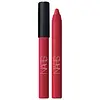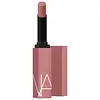What's inside
What's inside
 Key Ingredients
Key Ingredients

 Benefits
Benefits

No benefits
 Concerns
Concerns

 Ingredients Side-by-side
Ingredients Side-by-side

Dimethicone
EmollientTrimethylsiloxysilicate
EmollientCaprylyl Methicone
Skin ConditioningOctyldodecanol
EmollientSynthetic Wax
AbrasiveLauroyl Lysine
Skin ConditioningPhenylpropyldimethylsiloxysilicate
EmollientDiisostearyl Malate
EmollientPolyethylene
AbrasiveCopernicia Cerifera Wax
Stearyl Heptanoate
EmollientStearyl Caprylate
EmollientPentaerythrityl Tetra-Di-T-Butyl Hydroxyhydrocinnamate
AntioxidantPolyhydroxystearic Acid
EmulsifyingCaprylic/Capric Triglyceride
MaskingIsostearic Acid
CleansingLecithin
EmollientPolyglyceryl-3 Polyricinoleate
EmulsifyingDisteardimonium Hectorite
StabilisingPropylene Carbonate
SolventIron Oxides
CI 45410
Cosmetic ColorantCI 15850
Cosmetic ColorantCI 19140
Cosmetic ColorantDimethicone, Trimethylsiloxysilicate, Caprylyl Methicone, Octyldodecanol, Synthetic Wax, Lauroyl Lysine, Phenylpropyldimethylsiloxysilicate, Diisostearyl Malate, Polyethylene, Copernicia Cerifera Wax, Stearyl Heptanoate, Stearyl Caprylate, Pentaerythrityl Tetra-Di-T-Butyl Hydroxyhydrocinnamate, Polyhydroxystearic Acid, Caprylic/Capric Triglyceride, Isostearic Acid, Lecithin, Polyglyceryl-3 Polyricinoleate, Disteardimonium Hectorite, Propylene Carbonate, Iron Oxides, CI 45410, CI 15850, CI 19140
Isododecane
EmollientSynthetic Wax
AbrasivePolyglyceryl-2 Triisostearate
EmulsifyingCaprylyl Methicone
Skin ConditioningOctyldodecanol
EmollientDicalcium Phosphate
AbrasiveHydrogenated Microcrystalline Wax
Emulsion StabilisingLauroyl Lysine
Skin ConditioningTrimethylsiloxysilicate
EmollientPolyethylene
AbrasiveHydrogenated Styrene/Isoprene Copolymer
Polysilicone-11
Pentaerythrityl Tetra-Di-T-Butyl Hydroxyhydrocinnamate
AntioxidantPolyhydroxystearic Acid
EmulsifyingTocopheryl Acetate
AntioxidantCI 42090
Cosmetic ColorantIron Oxides
CI 45410
Cosmetic ColorantCI 15850
Cosmetic ColorantCI 77891
Cosmetic ColorantCI 19140
Cosmetic ColorantCI 15985
Cosmetic ColorantIsododecane, Synthetic Wax, Polyglyceryl-2 Triisostearate, Caprylyl Methicone, Octyldodecanol, Dicalcium Phosphate, Hydrogenated Microcrystalline Wax, Lauroyl Lysine, Trimethylsiloxysilicate, Polyethylene, Hydrogenated Styrene/Isoprene Copolymer, Polysilicone-11, Pentaerythrityl Tetra-Di-T-Butyl Hydroxyhydrocinnamate, Polyhydroxystearic Acid, Tocopheryl Acetate, CI 42090, Iron Oxides, CI 45410, CI 15850, CI 77891, CI 19140, CI 15985
 Reviews
Reviews

Ingredients Explained
These ingredients are found in both products.
Ingredients higher up in an ingredient list are typically present in a larger amount.
Caprylyl Methicone is a type of silicone.
It helps soften and soothe the skin by creating a thin film on top. This film helps trap moisture, keeping your skin hydrated.
Ci 15850 is the pigment color red. It is an azo dye and created synthetically.
Azo dyes need to be thoroughly purified before use. This allows them to be more stable and longer-lasting.
This ingredient is common in foundations, lipsticks, and blushes. This color is described as brown/orangey red.
It has many secondary names such as Red 6 and Red 7. According to a manufacturer, Red 6 usually contains aluminum.
Learn more about CI 15850CI 19140 is also known as Tartrazine. Tartrazine is a synthetic dye used in cosmetics, foods, and medicine to add a yellow color.
Tartrazine is created from petroleum and is water-soluble.
Some people may experience allergies from this dye, especially asthmatics and those with an aspirin intolerance.
Learn more about CI 19140CI 45410 is a synthetic red-pigment and dye.
It often goes by both Red 28 or Red 27; manufacturers label both ingredients as CI 45410.
This dye is commonly found in makeup because it imparts a vivid color. Some types of this dye change color based on pH level and interaction with moisture:
Your skin has a natural pH of around 4.5 - 5.5.
According to the FDA, CI 45410 is not permitted for use in eye products.
Red 27 is a flourescein dye and commonly used as a fluorescent tracer in medicine.
Learn more about CI 45410This ingredient comes from a fatty acid (lauric acid) and amino acid (lysine). It is used to add a silky feel to cosmetics.
According to a manufacturer, its fatty acid base leaves a silky feeling on the skin. It also has emollient properties because of this. Emollients help soften skin by preventing water from evaporating.
Lauroyl lysine is barely soluble in water.
Learn more about Lauroyl LysineOctyldodecanol is a fatty alcohol. It is primarily used to enhance the texture of products.
As an emulsifier, Octyldodecanol helps prevent the oils and waters from separating. It also prevents ingredients from creating foam when shaken.
Octyldodecanol is created by reducing fatty acid to an alcohol.
Due to its high molecular weight, it does not get absorbed into the skin.
Learn more about OctyldodecanolPentaerythrityl Tetra-Di-T-Butyl Hydroxyhydrocinnamate (long name, huh?) is a synthetic antioxidant.
It is used to help stabilize other antioxidants or prevent the color from changing in a product.
As an antioxidant, it helps fight free-radical molecules. Free-radical molecules are capable of damaging our cells and other genetic material. Thus, antioxidants may reduce the signs of aging.
This ingredient is oil-soluble.
Learn more about Pentaerythrityl Tetra-Di-T-Butyl HydroxyhydrocinnamatePolyethylene is a synthetic ingredient that helps the skin retain moisture. It is a polymer.
It is also typically used within product formulations to help bind solid ingredients together and thicken oil-based ingredients. When added to balms and emulsions, it helps increase the melting point temperature.
Polyhydroxystearic Acid is a soft wax made from castor oil.
It is is a texture thickener, emulsifier, and film-former. Emulsifiers prevent ingredients from separating, such as oils and waters.
Polyhydroxystearic Acid may not be fungal acne safe.
Learn more about Polyhydroxystearic AcidSynthetic Wax is created from fossil fuels such as natural gas. It is used to enhance texture, adjust pH, and as an occlusive.
It may also be used as an abrasive ingredient to exfoliate the skin.
Synthetic Wax may not be fungal acne safe.
Learn more about Synthetic WaxThis silicone is an emollient. Emollients create a thin film on the skin to prevent moisture from escaping.
It is not soluble in water and helps increase water-resistance in products.
According to a manufacturer, it can blend seamlessly with silicone oils, such as Cyclopentasiloxane.
Learn more about TrimethylsiloxysilicateThis ingredient is a combination of red, black, and yellow iron oxide pigments. This combination of colors is usually found in foundation, because it results in a "skin" color.